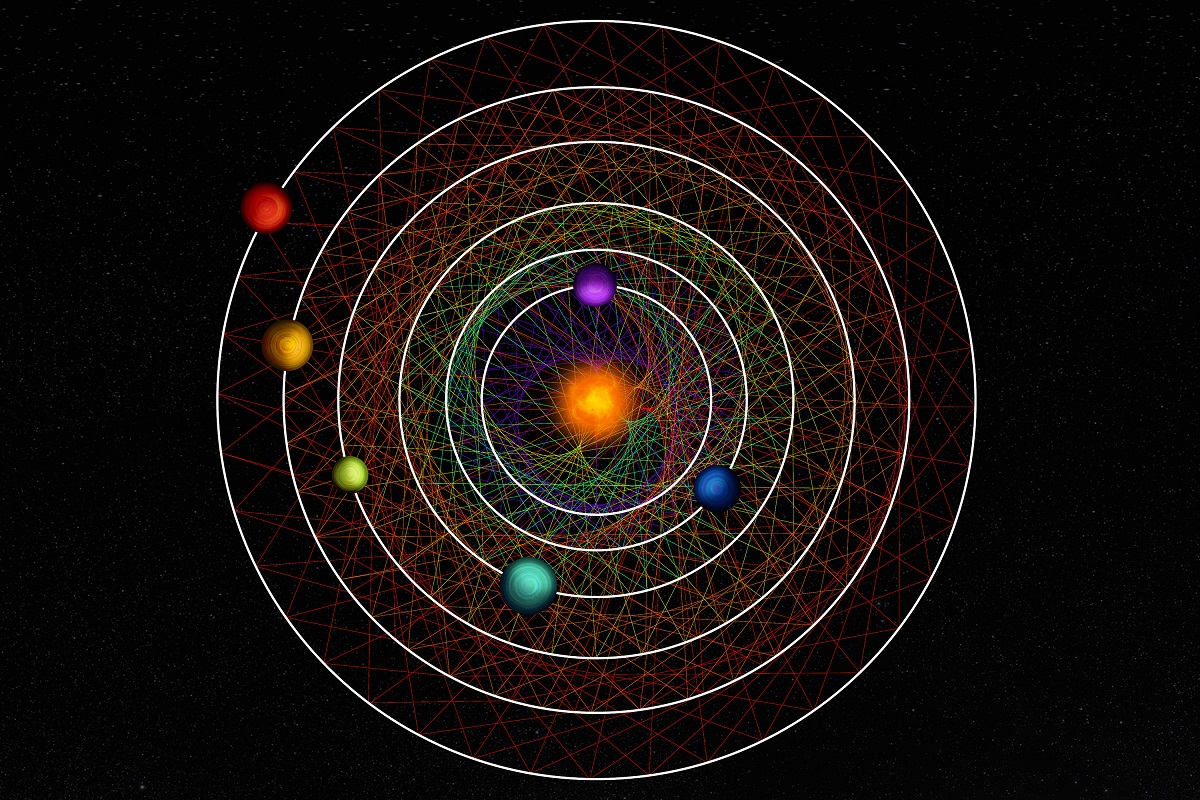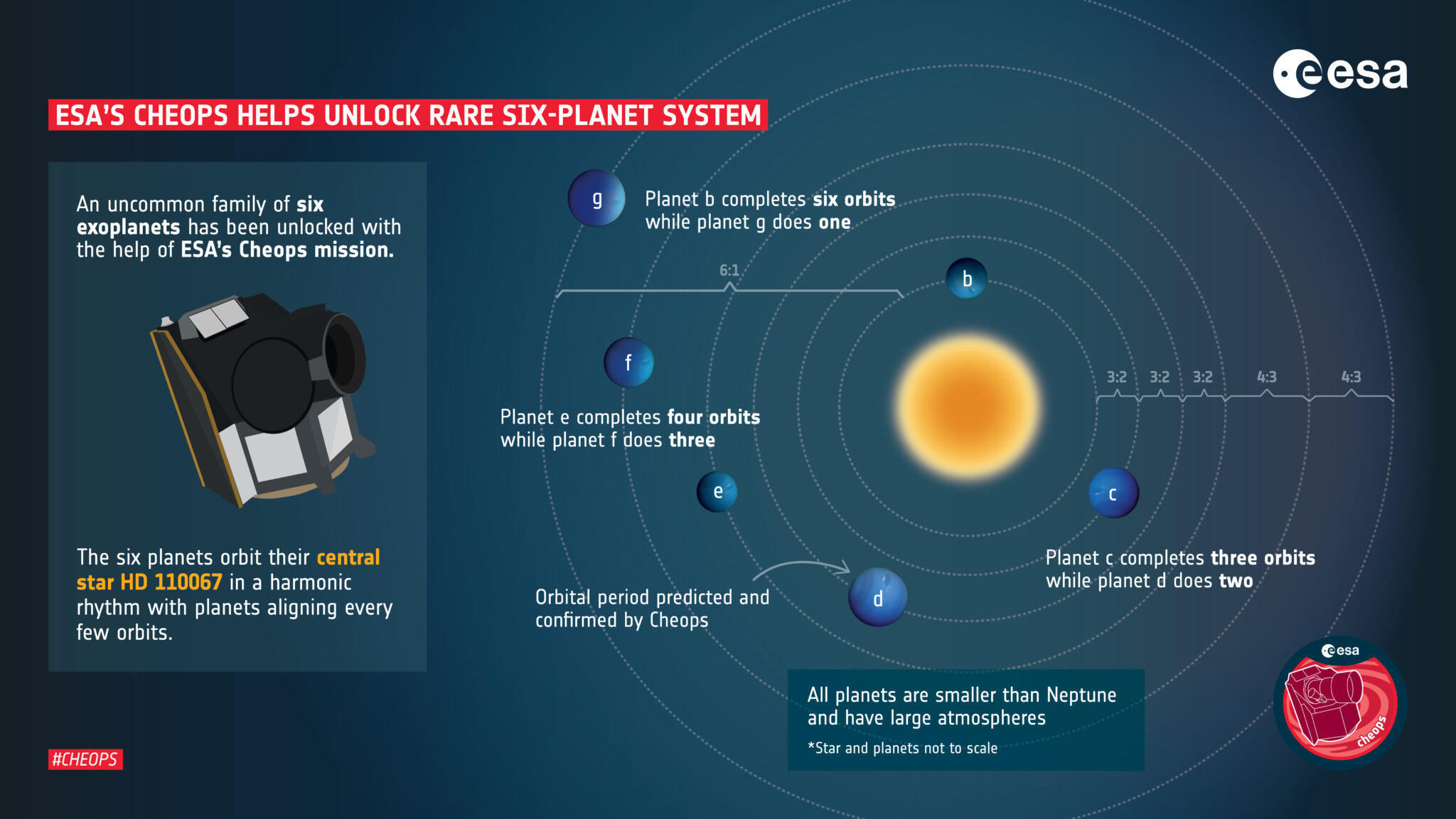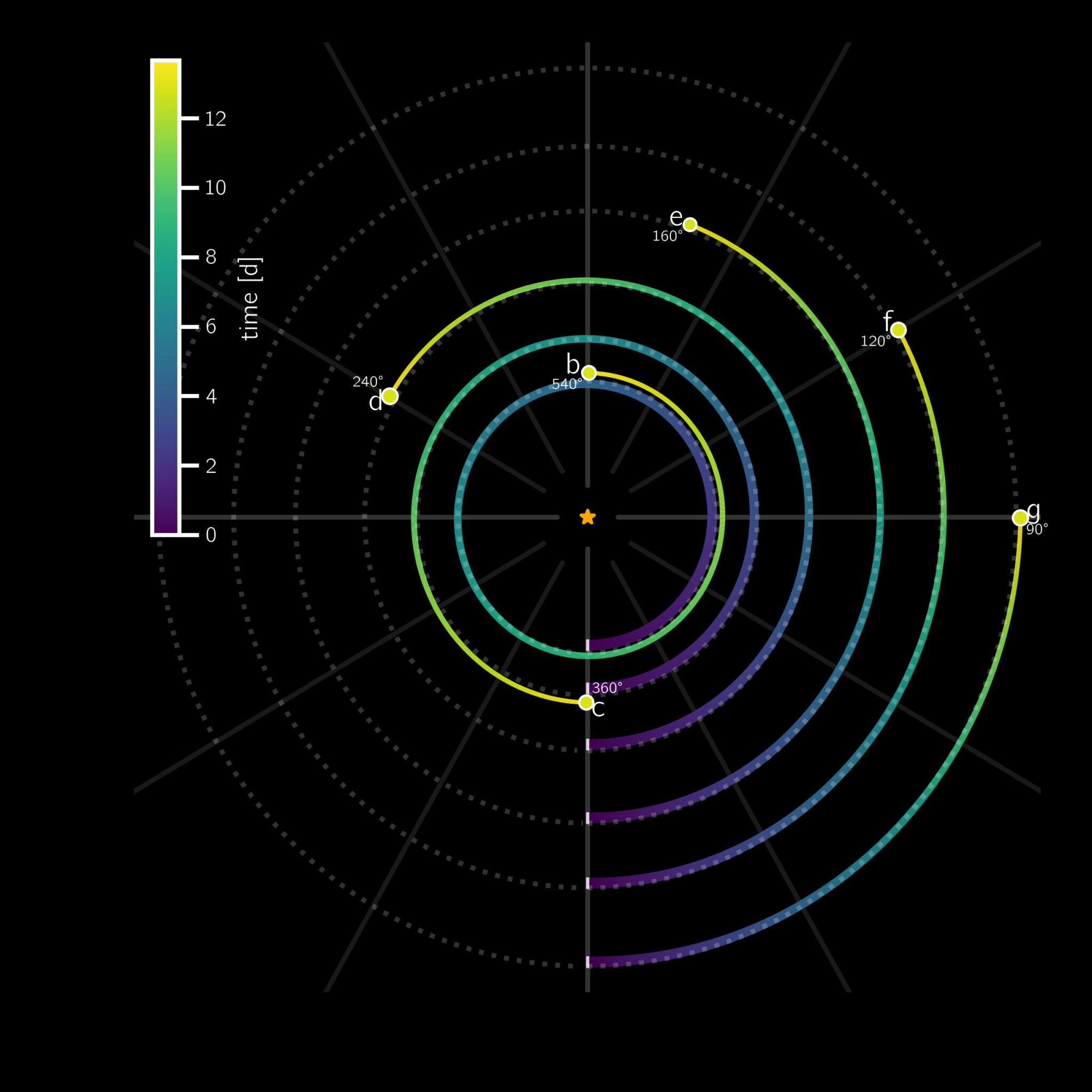Astronomers discover six planets thanks to their synchronised orbits
- The planets orbit their central star in sync, following a predictable rhythm astronomers call ‘resonance’
- This configuration shows that the planetary system has not suffered major changes since its formation more than a billion years ago
- IEEC researchers at the Institute of Space Sciences (ICE-CSIC) have participated in this discovery, which uses observations from the CARMENES instrument in Calar Alto and data from the ESA CHEOPS mission

Caption: Tracing a link between two neighbour planets at regular time intervals along their orbits, creates a pattern unique to each couple. The six planets of the HD 110067 system create together a mesmerising geometric pattern due to their resonance-chain.
Credits: Thibaut Roger/NCCR PlanetS, CC BY-NC-SA 4.0
Astronomers have found a peculiar family of six planets orbiting a star similar to the Sun called HD 110067. While multi-planet systems are common in our galaxy, those in a tight gravitational formation known as ‘resonance’ are observed far less often. An international team of researchers led by Rafael Luque, of the University of Chicago, have published today a paper on this discovery in the journal Nature. Several researchers from the Institute of Space Studies of Catalonia (IEEC — Institut d’Estudis Espacials de Catalunya) at the Institute of Space Sciences (ICE-CSIC) have participated in the research.
The resonant configuration means that the orbits are synchronised in a particular manner. In this case, the planet closest to the star makes three orbits for every two of the next planet out—called a 3/2 resonance—a pattern that is repeated among the four closest planets. For the outermost planets, it is four orbits for every three of the next planet out—a 4/3 resonance.
Orbitally resonant systems like this are extremely important to find because they tell astronomers about the formation and subsequent evolution of the planetary system. Planetary systems tend to form in resonance but can be easily perturbed. For example, a very massive planet in the system, a close encounter with a passing star or any kind of merger or collision can disrupt the careful balance. Finding a resonant system, thus, is like looking at a ‘fossil’ planetary system.

Caption: A rare family of six exoplanets has been unlocked with the help of ESA’s Cheops mission. The planets are all smaller than Neptune and revolve around their star HD 110067 in a very precise waltz. When the closest planet to the star makes three full revolutions around it, the second one makes exactly two—this is called a 3:2 resonance. Cheops confirmed the orbital period of the third planet in the system, which was the key to unlocking the rhythm of the entire system. This is the second planetary system in orbital resonance that Cheops has helped reveal.
Credits: ESA
Juan Carlos Morales, Guillem Anglada-Escudé and Ignasi Ribas, all of them IEEC researchers at the ICE-CSIC, participated in the research by providing observations carried out with CARMENES, the instrument searching for exoplanets from the Calar Alto Observatory. They also collaborated by scheduling observations with the CARMENES scheduler based on the STARS software, an artificial intelligence solution for planning operations of space missions and astronomical instruments developed by the IEEC, the ICE-CSIC and the Institute of Cosmos Sciences of the University of Barcelona (ICCUB).
“The CARMENES high-resolution spectroscopic observations spanning one year, along with those from the HARPS-N spectrograph, were used to determine the mass of three of the planets in the system and set stringent constraints to the others, revealing they are what we call sub-Neptune class planets,” explains Juan Carlos Morales, IEEC researcher at the ICE-CSIC.
HD 110067 invites further study as it shows us the unaltered configuration of a planetary system that has kept its resonance since its formation: the planets have likely been performing this same gravitational dance since the system formed billions of years ago. Moreover, this is the brightest known system with four or more planets. Since those planets are all sub-Neptune-sized with atmospheres that are likely extended, it makes them ideal candidates for studying the composition of their atmospheres using the James Webb Space Telescope of NASA, the European Space Agency (ESA) and the Canadian Space Agency (CSA).
“The CARMENES observations were used to determine the mass of three of the planets in the system and set stringent constraints to the others, revealing they are what we call sub-Neptune class planets,” explains Juan Carlos Morales, IEEC researcher at the ICE-CSIC.
Following the clues to find the planets
Caption: To-scale animation of the orbits of the six resonant planets in the HD 110067 system. The background image is the TESS field centred on HD 110067 from which the first hints of exoplanets orbiting the star were first seen (Credit: NASA/MIT/TESS and Ethan Kruse). The relative sizes of the planets (as shown by the key to the right) is accurate, although their true size compared to the star is much smaller.
Credits: Animation, composition and annotations by Dr Hugh Osborn (University of Bern)
The discovery of these planets is something of a detective story. The first hints came from NASA’s Transiting Exoplanet Survey Satellite (TESS), which aims at scanning all of the sky bit by bit to find exoplanets with short periods, that is, short years. In 2020, TESS detected dips in the brightness of the star HD 110067, which indicated planets were passing in front of its surface. These tiny eclipses are what astronomers call ‘transits’.
Two years later, TESS re-observed the same star. Adding up both sets of measurements, scientists had an assortment of transits to study. But it was difficult to distinguish how many planets they represented, or to pin down their orbits; the two sets of observations seemed to disagree.
“That’s when we decided to use CHEOPS,” explains Rafael Luque. CHEOPS is the Characterising Exoplanet Satellite, the first ESA mission devoted to studying bright, nearby stars that are already known to host exoplanets, which counts with IEEC and ICE-CSIC participation. “We went fishing for signals among all the potential periods that those planets could have,” says Luque.
Eventually, astronomers singled out the two innermost planets, with orbital periods of 9 days for the closest planet and 14 days for the next one out. A third planet, with a year about 20.5 days long, was identified with the help of the data from CHEOPS.
Then the scientists noticed something extraordinary: the three planets’ orbits matched what would be expected if they were locked in a 3/2 resonance. They had found the key to unlocking the whole system. The science team worked through a well-known list of resonances that potentially could be found in such systems, trying to match them to the remaining transits that had been picked up by TESS. The scientists could therefore predict that the outer three planets have orbital periods of 31, 41 and 55 days. “CHEOPS gave us this resonant configuration that allowed us to predict all the other periods. Without that detection from CHEOPS, it would have been impossible,” explains Luque.
However, the TESS observations that had any chance of confirming the predicted orbits of the two outer planets had been set aside during processing, as they had excessive scattered light. Reanalysis of the data to correct for the excessive light revealed two hidden transits, one from each of the planets, exactly at the times expected by the predictions. All the pieces of the puzzle had finally come together.
Press release prepared in collaboration with the University of Chicago, ESA and NASA.

Caption: Orbital motion for all six planets relative to a single year of planet c. Due to the precise resonant orbits of all six planets, the orbits of each planet are closely linked. For every 360 degree rotation around HD 110067 from planet c, planet b moves 540º, planet d 240º, planet e 160º, planet f 120º and planet g 90 degrees.
Credits: Dr Hugh Osborn (University of Bern)
More information
This research is presented in a paper entitled “A resonant sextuplet of sub-Neptunes transiting the bright star HD 110067”, by Rafael Luque et al., to appear in the journal Nature on 29 November 2023. DOI 10.1038/s41586-023-06692-3
Contacts
IEEC Communication Office
Barcelona, Spain
E-mail: comunicacio@ieec.cat
Lead Researcher at the IEEC
Barcelona, Spain
Juan Carlos Morales
Institute of Space Studies of Catalonia (IEEC)
Institute of Space Sciences (ICE-CSIC)
E-mail: morales@ieec.cat
About the IEEC
The Institute of Space Studies of Catalonia (IEEC — Institut d’Estudis Espacials de Catalunya) promotes and coordinates space research and technology development in Catalonia for the benefit of society. IEEC fosters collaborations both locally and worldwide and is an efficient agent of knowledge, innovation and technology transfer. As a result of more than 25 years of high-quality research, done in collaboration with major international organisations, IEEC ranks among the best international research centres, focusing on areas such as: astrophysics, cosmology, planetary science, and Earth Observation. IEEC’s engineering division develops instrumentation for ground- and space-based projects, and has extensive experience in working with private or public organisations from the aerospace and other innovation sectors.
The IEEC is a non-profit public sector foundation that was established in February 1996. It has a Board of Trustees composed of the Generalitat de Catalunya, Universitat de Barcelona (UB), Universitat Autònoma de Barcelona (UAB), Universitat Politècnica de Catalunya · BarcelonaTech (UPC), and the Spanish Research Council (CSIC). The IEEC is also a CERCA centre.
